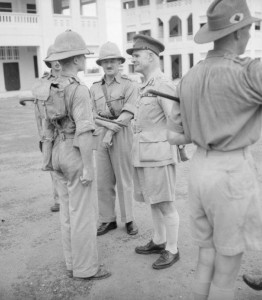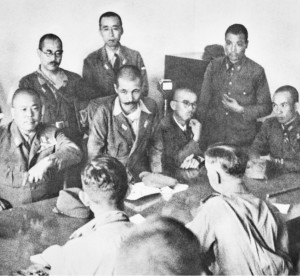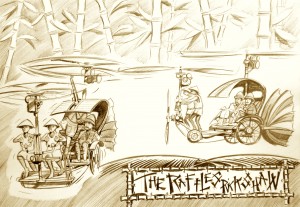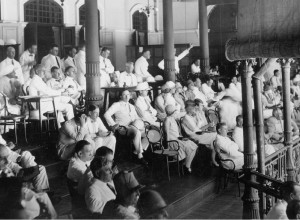The Raffles Rickshaw or the Percival rota-shaw
Dear reader, with Christmas fast approaching, spare a thought for those who celebrated Christmas some seventy four years ago in the steamy tropical heat of Singapore. And who, stimulated by the need for decisive action and prodigious feats of efficiency contrived a remarkable engineering tour de force from the rudiments of bicycle and staionary engines. Indeed such stirring tales go to the very heart in our quest to become truly, the world leaders in innovation.
The esteemed war historian and tactician Sir Basil Liddell Hart devoted many tomes to notion of ‘The other side of the hill”, in as much as he described the fortunes of battle and command therein to be able to envisage what what happening on the other side of the hill. The point being to imagine what your adversary would be thinking and in so doing calculate an approach that would both engage, surprise, and carry the day with thoughtful use of resources.
Such was the dilemma that faced the allied command prior to the Japanese Invasion of Singapore. Allied intelligence was grossly deficient, believing that troops of the Imperial Japanese Army would be height challenged, myopic, and possess imperfect bicuspids. They also believed that the infantryman had acquired through carrying baskets on poles a tendency to stoop. Key to the japanese advance came the reported use of bicycles. Without sufficient bicycles the Allied High Command immersed itself in ways to counter Yamashita’s thrust southwards. With this in mind the Commander in Chief, the benighted General Percival, hit upon an idea whilst returning from Raffles to command headquarters in a rickshaw.

Flt. Lt. Richard, (Dick) Shaw being awarded his DCM in the grounds of Raffles Hotel December 24 1941. Shaw is seen here wearing his portable repair and puncture kit, and specialist silk, (non friction) flying bicycle wing trousers.
Staggered by the stamina demonstrated by the rickshaw driver he imagined, (to prove that the higher command was not bereft of imagination) what a rickshaw could do in the right hands if it were assisted by auxiliary power and adapted as a short hop liaison aircraft. Seized by the potentialities and confident in the prowess of Empire arms to thwart the enemy he summoned his senior officers and called a general meeting and subsequent inspection of the Sha-tin-Shu Bicycle and Rickshaw works. What he discovered upon the inspection astounded him. Unbeknown to the high command the inventive proprietor, was already experimenting with a powered rickshaw, and improvising a collapsable parasol wing and a primitive landing gear that offered comfortable telescopic forks and twin powered “drivers”. Wasting no time Percival ordered a demonstration for General Wavell, and so impressed were the officers when flying over the Singapore Cricket Club, the incredibly named pilot, Lieut, R, (‘Rick’) Shaw threw a cricket ball from the rickshaw and demolished a street vendors tea urn. The basic rickshaw was refined with a forward and rear control rotor. Cleverly, a VTOL capability had been introduced by adding a geared rotor to the forward control mechanism, (a bicycle handlebar) and a hand mixer to provide additional lift. Specially adapted tubing and helium balloons were fitted if extra lift was required over long journeys, and the specifications of feeding drivers’ cabbage before such sorties mandatory.
Sensing that history was theres to be made, Percival ordered the immediate construction of twenty and augmented the power system with a J.A Prestwick 3.5 hp stationary engine for the rotor and adapted a Villiers 1.34 h.p for the rear rotor. The wings were reinforced with rice paper and a rudimentary armament, a .303 Lee Enfield installed to fire through the canopy. With precious days left to save Singapore, the No’s 1 and 2 RAF Rickshaw Squadron were launched against Yamashita’s fury. Initially the results proved encouraging, seasoned zero pilots when faced with the massed rickshaws couldn’t out manouevre nor gain sufficient deflection to engage. More often than not their bullets passed harmlessly through.

The fury of Yamashita! General Yamashita flanked by officers demands from Percival the plans for the Raffles Rickshaw.
Of little more than nuisance value they did score several early victories when a squadron of Nakajimas from the hard living 69 squadron seeing them, believed themselves to be under the weather from the night before, became disorientated and crashed. But within days the wily Japanese had developed a new tactic. By filling the bomb bays of no. 345 Betty squadron with sweet sticky rice they let go their glutinous cargo over the Rickshaw Squadron standing patrol above the Singapore Cricket Club. The coolies were rice blinded and the sprockets clogged and rendered inoperable. Pedaling furiously the operators established critical friction and the glutinous mass clinging to the working parts overheated, and burst into flames. Moments later they “plopped” flaming from the sky. This operation, code named ‘Sticky Rice’, removed the rickshaws overnight. For Percival this was the bitterest blow, as his reputation, both as a tactician and thinker were ruined. Singapore fell soon after.
Fatefully; as the Japanese proverb goes; ‘If rickshaw fry, you have problem’.
Raffles Rickshaw Specifications General Characteristics
Crew: 3.(two drivers). One flight Officer in sedan.
Range: 85 miles Vehicle: 1 x Shat in Shu Rickshaw
Powerplant: 1x JA Prestwick 3.5 hp. 1x 1.35 Villiers Stationery Single cylinder 1 kg cooked and sweetened rice per hr
Performance Maximum speed: 20 mph, 38 kmh. Range: 85 miles Service ceiling; 4,500 ft Rate of climb; 120 ft/min Armament 1 x .303 Lee Enfield firing through canopy. 2 x Mills hand grenade. 1 x Webley revolver Operators: RAAF, RAF


